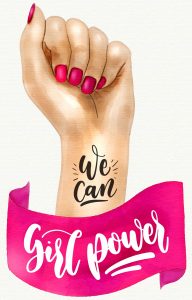Through Her PRspective
Published on April 14, 2021 at 5:40 p.m.
by Emma Britt.
“That’s pretty good for a girl” is something that cannot be said within the public relations industry, simply because women make up the majority of the workforce. According to The Plank Center for Leadership in Public Relations, 70% of the public relations workforce is made up of women, but only 30% of the leadership roles within the industry are held by women. How does this add up?
 According to The Atlantic, the gender breakdown within the communication industry is very clear: roles such as ad managers, PR managers, reporters, editors and journalists, all hold women as the majority of employed rather than men. The importance of women within the public relations field is quite substantial, making gender equality an essential priority of the field’s growth over time.
According to The Atlantic, the gender breakdown within the communication industry is very clear: roles such as ad managers, PR managers, reporters, editors and journalists, all hold women as the majority of employed rather than men. The importance of women within the public relations field is quite substantial, making gender equality an essential priority of the field’s growth over time.
Fire Scholars claims that women are drawn toward jobs in the public relations field because the roles allow them to communicate while also being creative. Whether it is the traits they are born with, the skills they learn over time or the experiences they gain through academics, women especially have what it takes to be successful PR professionals. But just because they are born with a skill or acquire it over time, does that mean they are respected for it?
The significant spike in women’s roles within the industry makes it hard not to notice or discuss. Feminization is apparent when looking at the demographics of the gender discrepancies within the public relations industry. One of these discrepancies is the wage gap between men and women in PR professionals. PR Couture reported that women make 85% of the annual salary of men in the public relations field. Even though women make up 70% of the industry, they do not get paid an equal amount. There is no clear difference except for the obvious one: gender. This is proof of inequality within this industry, even further reflecting that of other industries.
Alana Doyle, account executive at Chamberlain Healthcare PR, works on drafting media materials, working directly with pharmaceutical clients and researching current news.

“I think a lot of the gender inequality in the PR space is tied to social norms and education around the industry. Men typically lean more into marketing or advertising, rather than public relations, although the fields share several parallels. In regards to men in leadership over women, we see this across the board in other industries. As the [PR] industry continues to shift and grow, I hope we will continue to see more women and diversity in leadership roles,” said Doyle.
Although Doyle does not report any specific examples of gender discrimination within her work, she does report that it is “definitely possible” due to the large increase of leadership roles of men rather than women.
Hilary Waks, current director at Small Girls PR based in New York City, plans and strategizes for various clients, works within client communications and manages internal teams.
When talking about Small Girls PR, Waks emphasized the importance of diversity and a supportive work environment. SGPR donates to causes important to its employees and works with a number of pro bono clients. With a name like Small Girls PR, one would think that it is made up of all women, but Small Girls does have men on its team. Waks noted that the environment is all inclusive no matter the gender of its employees. Small Girls has a fun and nondiscriminatory environment to keep its spirit alive, she said.
When asked if Waks had ever experienced gender discrimination, she reported that there had been instances in her educational experiences where she felt less comfortable in class to speak up or ask questions, somewhat because they were male-dominated courses or fields. When asked why women dominate the PR industry, Waks said that women are good communicators and they take others’ emotions into consideration when making decisions. On the other hand, she determined that men tend to have more of a boldness when facing convictions, while sometimes not thinking to consider outside perspectives. Neither of these are negative things, she noted, just differences in ways the female and male brains operate and communicate. Both traits can be strengths and weaknesses when utilized in a public relations role.

There is no doubt that female public relations practitioners and professionals have gained respect and have attained more professional opportunities as the industry grows. But yet, there is still room for improvement. Female PR practitioners deserve to be treated and viewed as the confident, educated and well-equipped individuals they are. It is simply a fact that women are responsible for a substantial amount of the PR workforce; therefore, it is vital that to continue the growth within the industry, male and female public relations practitioners must work toward equality by constantly viewing each position through each other’s perspective.
The paychecks and respect level do not adequately represent this women-dominated industry. We deserve change.




